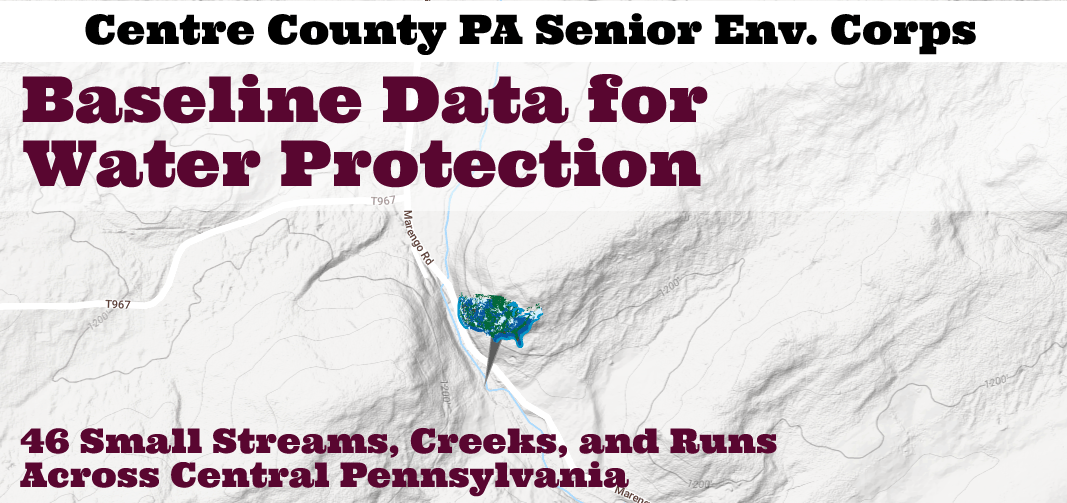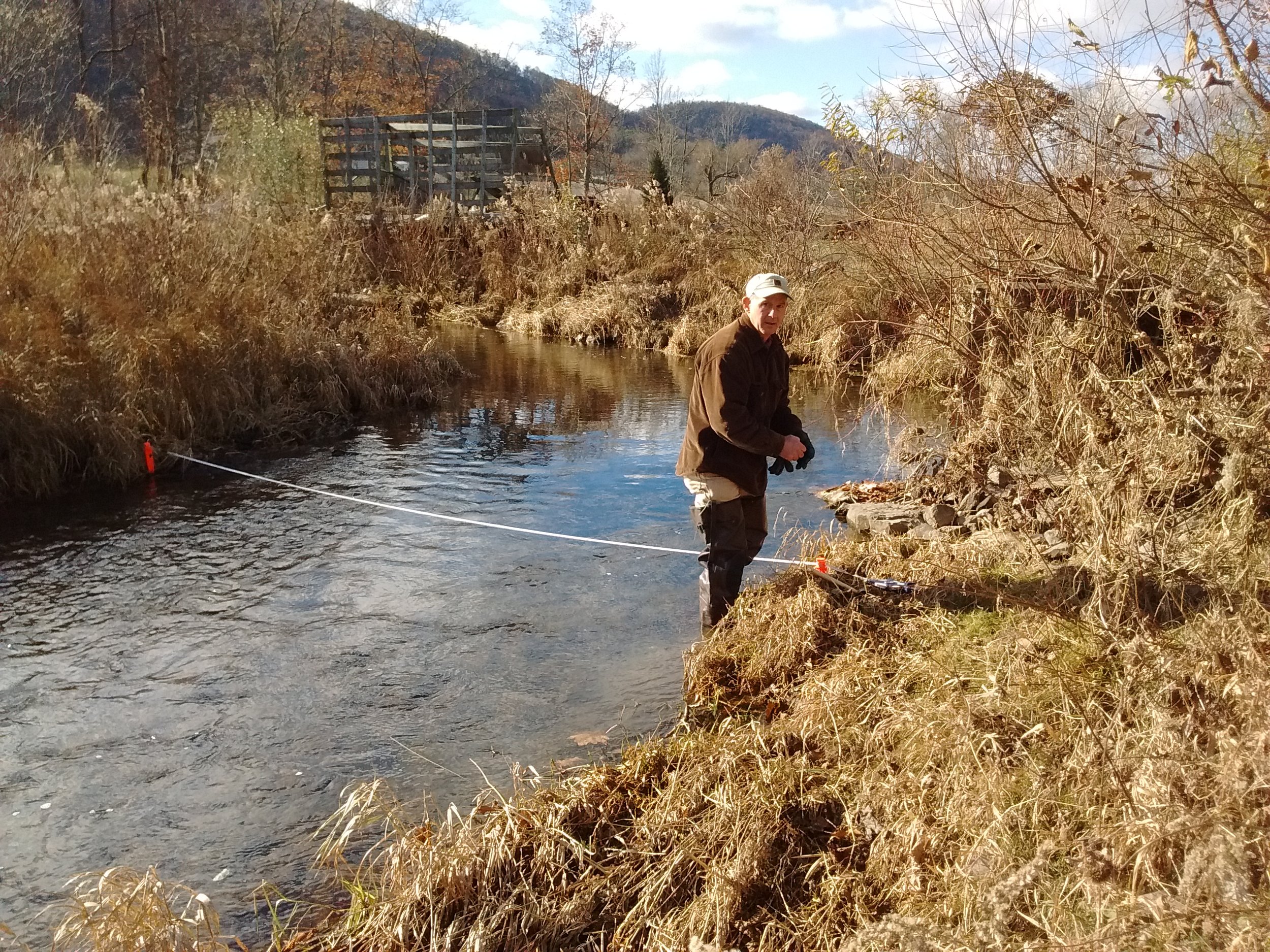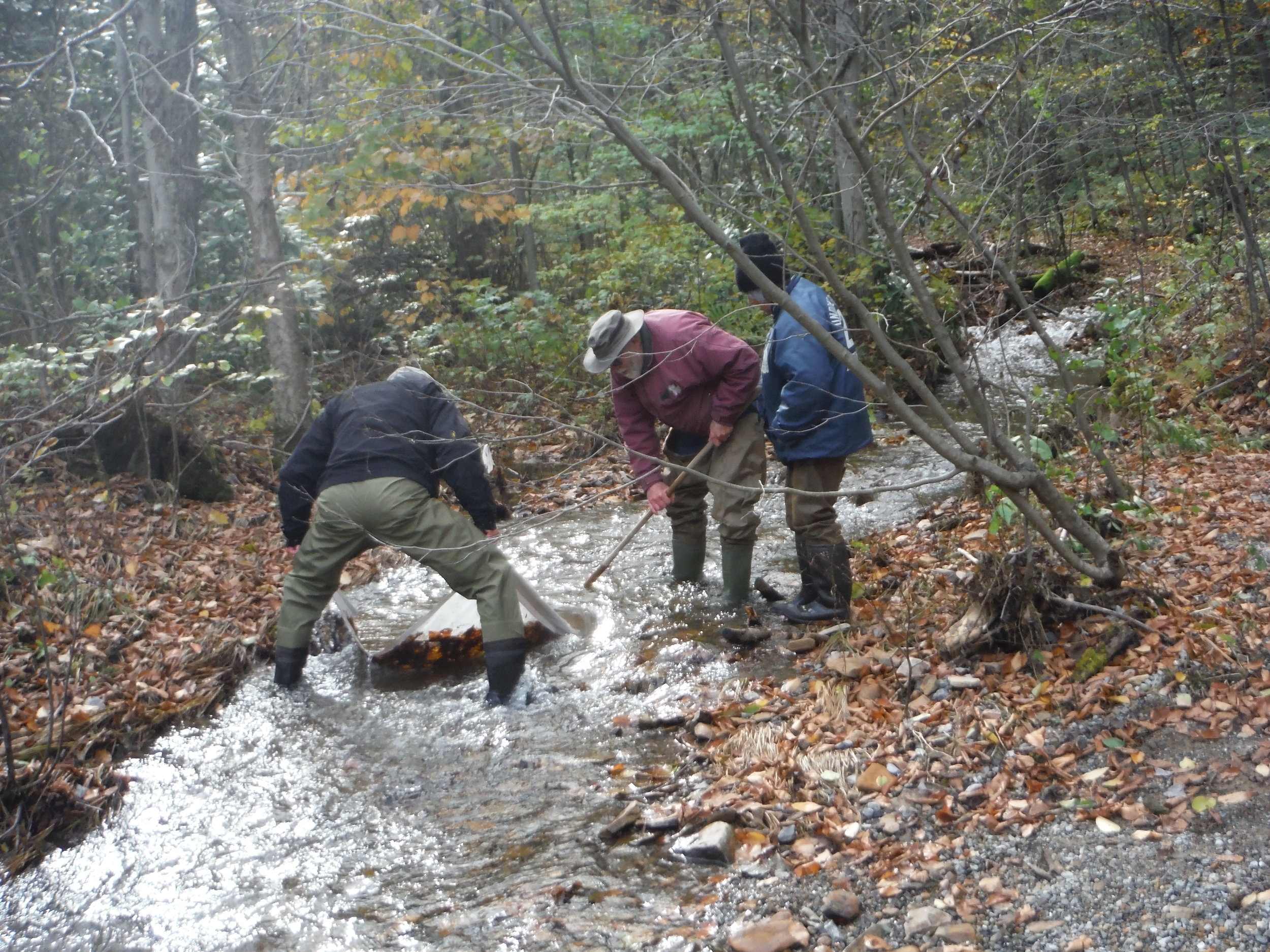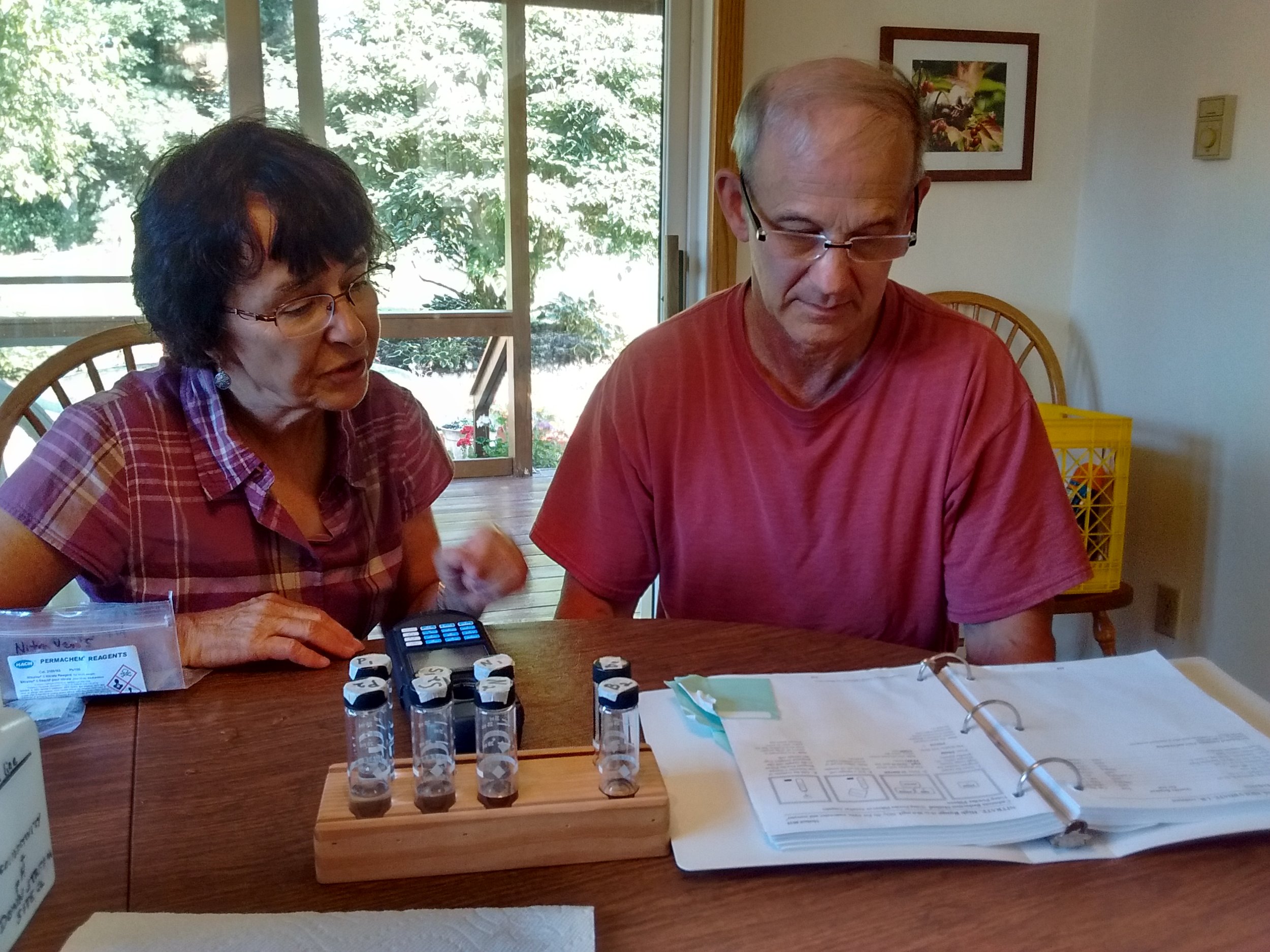Baseline Data for the Protection of Water Resources
The mission of the Centre County Pennsylvania Senior Environmental Corps (CCPaSEC) is to develop and support teams of senior citizens who gather and publish data on the quality of water in the streams of Centre County. With the assistance of the ClearWater Conservancy of Central Pennsylvania and Nature Abounds and in cooperation with Centre County Conservation District, CCPaSEC seeks to keep the public informed of the importance of clean water and how the management of our civil and natural resources affects the quality of streams in the county. The baseline data collected are used to detect significant anomalies that are then brought to the attention of the Pennsylvania Department of Environmental Protection for their action. Additional objectives are to promote the health and well-being of the participating seniors by providing meaningful social interactions among the volunteers through healthy physical, outdoors activity while sampling water quality
The Organization
The mission of the Centre County Pennsylvania Senior Environmental Corps (CCPaSEC) is to develop and support teams of senior citizens who gather and publish data on the quality of water in the streams of Centre County. With the assistance of the ClearWater Conservancy of Central Pennsylvania and Nature Abounds and in cooperation with Centre County Conservation District, CCPaSEC seeks to keep the public informed of the importance of clean water and how the management of our civil and natural resources affects the quality of streams in the county. The baseline data collected are used to detect significant anomalies that are then brought to the attention of the Pennsylvania Department of Environmental Protection for their action. Additional objectives are to promote the health and well-being of the participating seniors by providing meaningful social interactions among the volunteers through healthy physical, outdoors activity while sampling water quality
Concern for the quality and quantity of the water resources of Centre County initially spurred the founders of CCPaSEC, in the early 2000s, to develop ways of protecting that water. What was envisioned was a 'first observer' network of volunteers to continually monitor water quality. A second goal was to bring together like-minded retirees who have the time, energy, and interest in protecting the resources of our community in a way that is healthy, enjoyable, and meaningful.
The ongoing commitment of CCPaSEC's enthusiastic and dedicated volunteers is evidenced by the fact that in 2017, 2775 volunteer hours (worth $67,500) were logged and over 2400 hours were recorded in 2018 despite the frequent inclement weather conditions.
The Project
Over 60 senior citizens participate in the stream monitoring. Each of the 13 teams consists of three to six seniors who gather data at each site once a month from March through November and, when feasible, December-February.
A major weakness in our organization is that the teams must share sampling equipment. For the 13 teams, there are only 7 complete kits of equipment and chemicals available to conduct the sampling, requiring careful scheduling of sampling dates. High water and inclement weather events, like those in 2018, greatly complicate this scheduling. Our ultimate goal is to completely equip each of the teams. To move toward that goal, we propose that we begin to purchase the equipment and supplies over time, as funds become available. Because one complete sampling kit costs approximately $4500, we plan to begin purchasing as funds become available from this and other sources. We will continue to add to the baseline database.
Two categories of streams are monitored; 1) Marcellus Shale Region Sites; streams at risk to contamination by shale gas drilling (Beauty Run, north and south forks of Beech Creek, Big Run, Buffalo Run, Council Run, Eddy Lick Run, Hayes Run, Jonathan Run, Little Sandy Run, Monument Run, Panther Run, Salt Lick Run, Sandy Run, Sterling Run, Twin Run, Two Rock Run, Wolf Run, West Branch Big Run) and 2) Non-Marcellus Shale Region Sites at risk of contamination from agricultural, municipal, or bordering property owner activities (Bald Eagle Creek, Buffalo Run, Elk Creek, Galbraith Gap Run, Halfmoon Creek, Lick Run, Little Fishing Creek, Moose Run, Muddy Creek, Sinking Creek, Slab Cabin Run, Wallace Run).
Forty six (46) sites are sampled. At non-Marcellus shale sites, each team measures pH, depth, flow (cm per second, from which cu. m per sec is calculated and recorded), alkalinity, electrical conductivity, dissolved oxygen, sulfates, phosphates, nitrates, air temperature, and water temperature and notes clarity, odor, and sediments. All data are entered into a publicly available database (See Chemical/Physical Data <http://www.ccpasec.org/index.php/data>). At Marcellus shale sites, each team records water temperature, depth, flow, pH, dissolved oxygen, conductivity, total dissolved solids, and salinity. These data are entered into the publicly available database. A water sample is then sent to Dr. M. Khalequzzaman at Lock Haven University who uses mass spectroscopy to analyze mineral content as part of an ongoing research project.
Twice per year (spring and fall), sites are sampled for macroinvertebrates and, based on the diversity and numbers recorded, a stream health rating is calculated. (All data are entered into a publicly available database. See Biosurvey Data <http://www.ccpasec.org/index.php/data>).
Depending upon site, as of 2019, 3 to 17 years of data have been recorded, establishing a baseline. Although the data are not officially certified by an independent laboratory, they constitute an important, ongoing baseline of information and provide a ‘first observer’ record of stream health. In the event of a significant change in stream chemical, physical or biological conditions the Centre County Conservation District is immediately notified and the observations are passed along to other local authorities or the Pennsylvania Department of Environmental Protection (DEP).
Key Project Milestones
The value of CCPaSECs 'first observer' network are illustrated by two examples.
#1 - About 2011 or 2012, the team monitoring streams at risk to Marcellus shale drilling arrived at the Council Run site on the Kato-Orviston Rd. for their first visit of the calendar year. During the previous 2 years, they had observed a high volume of tank truck and other heavy tractor trailer traffic on that road hauling fracking water, equipment and supplies to a new Marcellus pad about 3 miles east of Council Run. The energy company, Anadarko, had this part of the K-O Rd. resurfaced with new limestone and graded it. Heavy rains along with the spring thaw caused massive erosion in the sampling site area. The large conduit/culvert that served as a bridge over Council Run was almost completely exposed and the road washed off of it. Also, the water no longer followed the natural gutters on the side of the K-O Rd. on its way to Council. It followed the path of least resistance, which was the newly graded road. This created a deep gouge across the Rattlesnake Camp road, and then gouged into the side of Council Run forming a new tributary. Much of the recently deposited aggregate was flushed into Council Run filling this formerly beautiful free stone stream bed with the crushed limestone aggregate. The team was concerned that the composition of the stream bed was altered and asked Ann Donovan (the Centre County Conservation District water specialist at that time) to assess the situation. Ann contacted the erosion specialist in her department and he worked together with Anadarko and Snow Shoe Township crews to correct the problem. By the fall of that year, a new boulder fortified bridge with a wooden railing was built across Council Run. Thirteen new culverts were installed to direct the water to its former course. The road was regraded and resurfaced with aggregate.
#2 - In February 2011 monitoring at Sinking Creek (site #10016 in the database <http://www.ccpasec.org/index.php/data>; Latitude 40 degrees 48.212N' and Longitude 77 degrees 09.298W') the team noticed that the values for dissolved oxygen, nitrate, and phosphate were all abnormal as compared to previous measurements. Our sampling occurred just as very heavy snowfalls were followed by a rapid rise in temperatures and extensive melting and runoff. The team contacted Ann Donovan (the Centre County Conservation District water specialist at that time) who in turn contacted the Pennsylvania Department of Environmental Protection (DEP). DEP investigated and found that a farm just upstream from our sampling site had established an animal waste site very close to Sinking Creek. When the air temperature resulted in the fast melting of the snow, the waste from this site leaked into Sinking Creek, causing the values of the chemical measurements to drastically change. These values are recorded in the CCPaSEC database for February 16, 2011.
Project Locations
46 sites across Central Pennsylvania
Rough Budget for This Project
$4,500 per sampling kit



